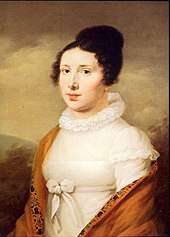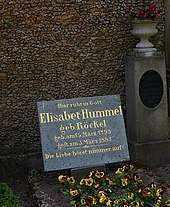Elisabeth Röckel
Elisabeth Röckel (15 March 1793, baptised "Maria Eva", Neunburg vorm Wald – 3 March 1883 in Weimar) was a German soprano opera singer and the wife of the composer Johann Nepomuk Hummel.



Life
She was a sister of the opera singer Joseph August Röckel (1783-1870) who played Florestan in the second version of Beethoven’s opera Fidelio, which premiered in the Theater an der Wien in 1806. In the same year she came to Vienna, too, where she lived in a flat in the theater, together with her brother. In a register of the residents of the theater she is named "Elis [!] Rökel". According to this register in another flat of the theater lived the famous singer Anna Milder-Hauptmann with her family, who played the title role of Fidelio. She became a close friend of Elisabeth. Many sources show that Elisabeth often met Beethoven who fell in love with the beautiful young girl and wanted to marry her.
But in April 1810 Elisabeth Röckel got an engagement at the theater in Bamberg where she made her stage debut as Donna Anna in Mozart's Don Giovanni and became a friend of the writer E. T. A. Hoffmann.
The German musicologist Klaus Martin Kopitz has suggested that Beethoven wrote his famous Bagatelle No. 25 for piano, commonly known as "Für Elise", in the days of Elisabeth Röckel's departure from Vienna. It had the inscription "Für Elise am 27 April zur Erinnerung von L. v. Bthvn" (For Elise on 27 April [1810] in memory of L. v. Bthvn). Indeed, Anna Milder-Hauptmann named her "Elise" in a letter to her.[1]
During the days before Beethoven's death, she and her husband Hummel visited Beethoven several times, and cut and saved a lock of his hair. This was later discovered in 1934 in Florence by Wilhelm Hummel, a descendant of Johann Nepomuk Hummel. The lock of hair is now in the Beethoven Center of the San Jose State University.[2]
References
Sources
- Mark Kroll: Johann Nepomuk Hummel: A Musician’s Life and World, Lanham, Maryland: Scarecrow Press 2007, ISBN 978-0-8108-5920-3
- Klaus Martin Kopitz: Beethoven, Elisabeth Röckel und das Albumblatt "Für Elise", Cologne: Dohr, 2010, ISBN 978-3-936655-87-2
- Michael Lorenz: "'Die enttarnte Elise'. Die kurze Karriere der Elisabeth Röckel als Beethovens 'Elise'", Bonner Beethoven-Studien vol. 9, Bonn: Beethoven-Haus, 2011, pp. 169–190 Abstract online
- Michael Lorenz: "Maria Eva Hummel. A Postscript", Vienna 2013
- Klaus Martin Kopitz: Beethovens "Elise" Elisabeth Röckel. Neue Aspekte zur Entstehung und Überlieferung des Klavierstücks WoO 59, Die Tonkunst, vol. 9, no. 1 (January 2015), pp. 48–57 (PDF)
Notes
- See Kopitz (2010), p. 45–57 and Kopitz (2015)
- William Meredith, New Acquisitions (Summer 2012): The Yvonne Hummel Collection, The Beethoven Journal, vol. 27, no. 2 (Winter 2012), pp. 74–80